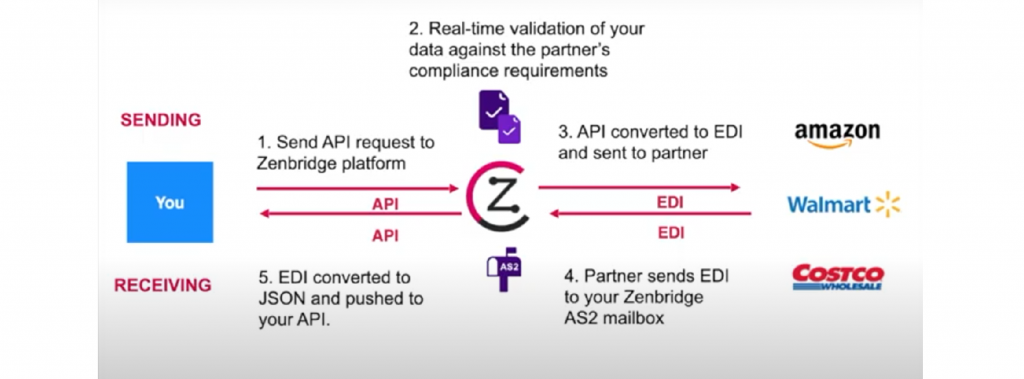
EDIFACT EDI Integration Using API
On January 19, 2023 by Shivam RawatIf you are a modern-day API developer who has the responsibility of carrying out EDIFACT EDI integration for your company, it would be pretty much impossible without hiring or relying on EDIFACT EDI experts. Fortunately, there’s a way to perform EDIFACT integrations using modern-day EDI-as-API platforms. Let’s take a closer look.
What is EDIFACT?
EDIFACT is the most popular EDI standard for B2B supply chain communications in Europe. It was developed by the United Nations to define rules and syntax for repetitive documents used in EDI. There are several versions of EDIFACT that emerged over time as more and more businesses narrowed or modified their EDI requirements. New EDIFACT specifications keep adding to the structure that defines how companies in different sectors interact with each other.
EDIFACT is used for the exchange of EDI in transport, manufacturing, logistics, etc., in sectors like retail, agriculture, and the public sector. Here are some commonly used EDIFACT documents:
| DELJIT | Delivery just-in-time message | specifies precise delivery sequence and just-in-time schedule requirements |
| DELFOR | Delivery schedule message | specifies short-term delivery or medium to long product schedule requirements |
| DESADV | Despatch advice message | specifies goods despatched or ready to dispatch on agreed conditions |
| INVOIC | Invoice message | specifies payment claims between sellers and buyers |
| INVRPT | Inventory report message | specifies information about held inventories between trading partners |
| ORDERS | Purchase order message | specifies the details for orders placed for goods or services |
| ORDCHG | Purchase order change request message | specifies the details from buyers to the seller to change a purchase order |
EDIFACT EDI integration using API
While there are traditional EDI software programs, which you can use to implement EDIFACT integrations, they are completely alien to most modern-day developers. Modern-day developers are familiar with API programming, though. This has resulted in the birth of a new kind of modern-age EDI integration software called EDI-as-API platforms (EDI via API.) You can read more on the comparison of the kinds of EDI solutions here.
Traditional EDI platforms cost more, take months to integrate, and have long queues for customer support. For a business that needs present-day solutions to set up its EDIFACT connection, the ideal choice today is EDI via API, and here’s why.
Almost every software system, including ERP, WMS, and eCommerce, is becoming API-centric. An API developer can manage all these systems, but EDIFACT integrations because it require exclusive EDI developers and infrastructure. So EDI via API makes total sense to most companies and is seeing increasing adoption.
Introduction to Zenbridge – EDI-as-API platform
One such EDI-as-API platform is Zenbridge. It gives you the ability to send & receive EDIFACT messages using API and webhooks. Let’s break it down.
Core EDI API parser:
What we have at the core of the system is a parser that can take in EDIFACT specifications and translate that into API (JSON or XML) models. The great news is that we support all documents and all versions of EDIFACT. So no matter which industry you or your trading partners belong to, you can use our API to transact EDIFACT messages.
Setting up an EDIFACT integration project:
The first step in setting up an EDIFACT integration project in Zenbridge is, configuring your trading partner’s EDIFACT specifications in the platform. We have an online EDIFACT specification editor that lets you configure your trading partner’s EDIFACT specifications. If you are not familiar with what specifications are, they are nothing but the list of mandatory and optional data points that need to be exchanged in an EDIFACT EDI file. Of course, it is not just a list. Rather, the data payload is formatted according to the EDIFACT standard.
Once EDIFACT specifications are set up, they are published in real-time as API endpoints and API documentation. For example, if your trading partner is Schwarz, and you configure their Purchase order spec on the platform, the following API endpoint would be published.
api.zenbridge.io/schwarz/orders
Send EDIFACT data to your trading partner (JSON to EDIFACT)
To send an EDIFACT file to your trading partner, all you need to do is send a JSON request to the Zenbridge platform. Zenbridge validates your API request against the trading partner’s compliance requirements. If the data meets the compliance requirements of your trading partner, the EDIFACT EDI file is generated, and you will receive an HTTP 200 response. The platform will then send the EDIFACT message to your partner’s AS2 / SFTP mailbox.
If the data is non-compliant (violates the trading partner’s EDI specification), you will get an HTTP 400 error in the API displaying error messages. The validation takes real-time to ensure you always send compliant EDIFACT files to your trading partner. It saves you time and money that you would spend correcting non-compliance documents if you were using a legacy EDI service.

Receiving EDIFACT using API from your trading partner (EDIFACT to JSON)
Zenbridge creates an AS2 mailbox for you when you sign up on the platform. Your trading partners will use this AS2 connection to send EDIFACT files to you. Zenbridge will validate their EDIFACT files against your compliance requirements. If everything is fine, it will get converted into JSON and sent to your API’s callback URL.
You can set up Webhook/callback URLs with Zenbridge to view the received JSON files. You can also view all your EDIFACT transactions in Zenbridge’s Dashboard.
EDIFACT API – Conclusion
There was no easy way of dealing with EDIFACT documents for API developers until now. The EDIFACT structure is complex enough to become a nightmare for most developers. Due to this reason, the legacy EDIFACT services today take the same 3-9 months as they used to a decade ago. That’s something that bothers most of their customers, who expect things done at their desired pace.
What we have done with Zenbridge is that we have opened up the world of EDI to modern-day developers. Today, Zenbridge is the only platform to support API for all EDIFACT EDI. If you would like to see a demo of our platform, schedule it here.

Leave a Reply